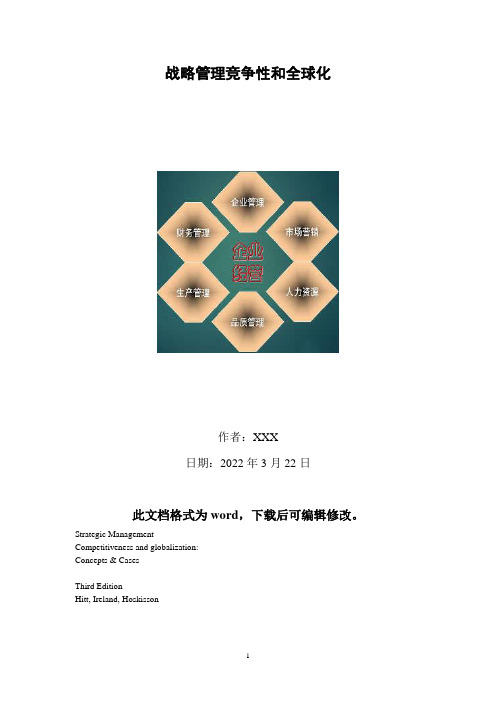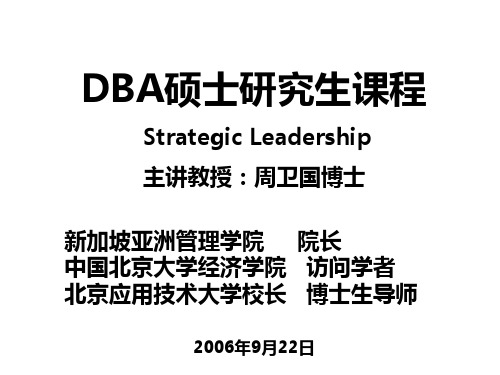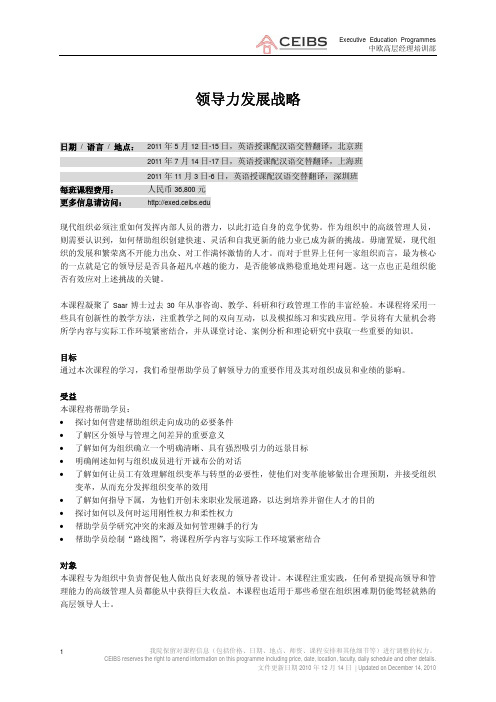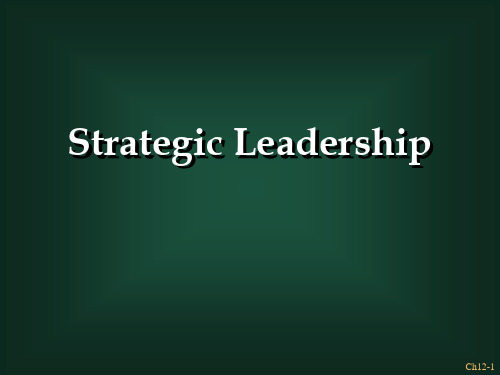Lecture 17-Strategic Leadership
- 格式:ppt
- 大小:236.50 KB
- 文档页数:14

02系列之二、领导力与战略管理201310第一篇:02 系列之二、领导力与战略管理201310“管理回报率提升”企业管理高级研修班系列之二《领导力与战略管理》课程背景无论是大型央企国企企业集团,还是发展中的民营企业,都面临着领导人员和管理人员后继乏人的困扰。
为什么?一是因为国内一直没有系统的领导力培训的理念和课程体系,二是因为现有的领导人和管理者没有接受过正规的教练辅导技术的训练,难以有效地传授领导力能力、技巧和艺术。
更何况还有很多身在领导岗位的人员本身并没有接受过相应的训练和学习,其领导力尚处于不及格的水平。
以至于领导力的继承、形成和发扬,处于“瞎子摸象”、“自由生长”、“自生自灭”、“东一榔头、西一棒子”、“今天一个偏方、明天一条警句”的状态。
传统的MBA教育只是传授了一些管理学的基本知识,教条割裂的课程内容、没有成功实践基础的学院派师资和授课方式难以培养出具有领导力的英才。
领导力的核心是创造愿景的梦划能力、定位事业的规划能力、整合资源的谋划能力、推进前进的计划能力。
这些能力和素质的基础就是“读万卷书、行万里路”,但是严峻的现实、紧迫的人才需求并没有给居于领导岗位的人员以足够的时间和空间。
怎么办?训练、教练和演练就成为了我们在有限的时间和空间内为领导力的提升奠定基础的有效方式。
真正的成长和提升,还在课后,在人生漫长的职业生涯的实践中、奋斗中。
本课程与您分享作者十年来研发的领导力提升相关研究成果,还会与您分享作者认真研读、颇有心得的领导力提升相关名著。
本课程以您所在企业的战略管理实践为案例,训练您在战略管理领域的领导力。
本课程的目的就是给予您一份领导力提升的导航图!【课程名称】《领导力与战略管理》【培训目的】提升企业高管人员领导力和战略管理能力【培训对象】董事长、总裁、总经理、高管团队成员。
【教学方式】结合企业管理实践、采用多年研发后创新的管理理论与研究成果、运用互动研讨和情景模拟等体验式授课形式进行系统讲授、同时可对学员关心问题作针对性解答交流。

战略管理竞争性和全球化作者:XXX日期:2022年3月22日此文档格式为word,下载后可编辑修改。
Strategic ManagementCompetitiveness and globalization:Concepts & CasesThird EditionHitt, Ireland, HoskissonChapter I Strategic Management and Strategic CompetitivenessChapter 2 The External Environment Opportunities, Threats, IndustryCompetition and Competitor AnalysisChapter 3 The internal Environment: Resources, Capabilities and CoreCompetencies Chapter 4 Business-Level StrategyChapter 5 Competitive DynamicsChapter 6 Corporate Level StrategyChapter 7 Acquisitions and RestructuringChapter 8 International StrategyChapter 9 Cooperative StrategiesChapter 10 Corporate GovernanceChapter 11 Organizational Structure and ControlChapter 12 Strategic LeadershipChapter 13 Corporate Entrepreneurship and innovationCHAPTER 1STRA TEGY & STRA TEGIC COMPETITIVENESSLearning Objectives:1. Understand thel. Define strategic competitiveness, competitive advantage and above-average returns.2. Discuss the challenge of strategicmanagement.3. Describe the new competitive landscape and how it is being shaped by global and technological changes.4. Use theindustrial organization (I/O) model to explain bow firms can earn above-average returns.5. Use the resources based model to explain how firms can earn above average-returns.6. Describe strategic intent and strategicmission and discuss their value to the strategic management process.7. Define stakeholders and describe the three primary stakeholder groups' ability to influence organizations.8. Describe the work of strategists.9. Explain the strategic management process.Chapter Outlines1. Strategy and Strategic Management2.The Challenge of Strategic Management:●The global economy and globalization,●Technological change and diffusion,The information age and increasing knowledge intensity3. The I/O Model of Above-Average Returns4.The Resource-based Model of Above-Average Returns5.Strategic Intent and Strategic Mission6.Stakeholdersanizational Strategists8.Review QuestionsTeaching Focus: It may be very good to begin this lecture with a general comment thatChapter I provides an overview ofthe strategic management process. In this Chapter, theAuthors introduces a numberof terms and models that students will study in more detail in Chapters 2 through 13. Stress the importance of students paying careful attention to theconcepts introduced in this Chapter so that they are well grounded in the strategicmanagement concept before proceeding further.This Chapter's Opening Case discusses the changes taking place in the telecommunications industry and the effects of these changes on the industry's competitive landscape.Opening Case A New World Order in the Telecommunications industryThe Federal Communications Commission voted to allow foreign companies increased accessto the U.S. market.A World Trade Organization Agreement saw 69 countries agree to open theirTelecommunications markets.Countries of the European Union are deregulating their telecommunications markets andpreviously protected franchises are now open to foreign and domestic competition.Emerging markets such as China present significant opportunities to telecommunications firmsfrom around the world.The ability of firms to compete successfully in this new competitive landscape, will bedetermined by their abilities to marshal (meaning: control and organize) vast amounts of resources. As an example, in 1996, therequired investment in the global telecommunicationsinfrastructure was $ 160 billion, an amountthat seems small compared to the $ 1 trillion opportunity in China alone. And vast investmentsalso will be required to maintain competitive technological parity throughout Europe and Asia aswell as in the U.S.As implied by the Chapter title---strategic Management and Strategic Competitiveness---and illustrated by the discussion of changes taking place in the telecommunications industry, the primary purpose ofthe strategic management process is to enable firms to achieve strategic competitiveness and earn above-average returns. An in-depth discussion of international (global) strategies will be found in Chapter 8.Definitions:strategyStrategic competitiveness is achieved when a firm successfully formulates and implements a value-creating strategy. By implementing a value-creating strategy that current and potentialcompetitors are not simultaneously implementing and that competitors are unable to duplicate the benefits of, a firm achieves a sustained or sustainable competitive advantage.Above average returns represent returns that exceed returns that investors expect to earn from other investments with similar levels of risk (investor uncertainty about theeconomic gains or losses that will result from a particular investment). In other words, above average-returns exceed investors' expected levels of return for given levels of risk.. So long as a firm can sustain (or maintain) a competitive advantage, investors will earn above-average returns.Teaching suggestion: Point out that, in the long run, firms must earn at least average returnsand provide investors with average returns ifthey are to survive. If a firm earns belowaverage returns and provides investors with below-average returns, investors will withdraw their funds and place them in investments that earn at least average returns.Strategic Management Process is a framework that can assist firms in their quest for strategic competitiveness, it is the full set of commitments, decisions and actions required fora firm to systematically achieve strategic competitiveness and earn above-average returns-This process is illustrated in Figure 1-1 .The dynamic nature ofthe strategic management process is indicated by feedback linkages among the three primary elements: strategic inputs, strategic actions and strategic outcomes.Strategic inputs, in the form of information gained by scrutinizing the internal environment and scanning the external environment are used to develop the firm's strategic intent andstrategic mission.Strategic actions are guided by the firm’s strategic intent and strategic mission, and are represented by strategies that are formulated or developed and subsequently implemented or put into action.Strategic outcome is the result of a firm’s strate gy implemented. A desired strategic outcome---strategic competitiveness and above-average returns---result when a firm is able to successfully formulate and implement value-creating strategies that others are unable to duplicate.Feedback links the elements ofthe strategic management process together and helps firms continuously adjust or revise strategic inputs and strategic actions in order to achieve desired strategic outcomes.This Chapter also will discuss two approaches to the strategic management process. The first,the industrial organization model, suggests that the external environment should be considered asthe primary determinant of a firm's strategic actions. The second is the resource-based model, which perceives the firm’s resources and capabilities (the internalenvironment) as critical linksto strategic competitiveness. Following the discussion in this Chapter, as well as in Chapters 2and 3, students should see that these models must be integrated to achieve strategicCompetitiveness.THE CHALLENGE OF STRATEGIC MANAGEMENTAs noted in earlier comments, all firms--and managers--are challenged to achieve strategic competitiveness and earn above-average returns. And, the challenge can be formidable. A primary challenge facing managers today is the need to recognize--as illustrated by the comments on such firms as IBM, Union Pacific, Honda and The Limited--that the strategic management process and the striving for strategic competitiveness takes place in a dynamic global economy. As a result of this ongoing struggle, success today does not necessarily equate with success tomorrow.Honda has had to make major changes to survive in the global automobile market. In its attempt to make its flagship Accord more sporty, it found that the car was too small to satisfy the expectations and not sporty enough to satisfy Japanese buyers. As a result, it has designed the Accord around a ``world car'' design with alterations to meet different market expectations. Its U.S. Accord is now larger, the Japanese model is smaller and contains more ofthe high-technology features desired by Japanese buyers and a smaller European version has been introduced.TABLEI-1 Top Ten Wealth CreatorsAs shown in Table 1-1, Coca-Cola and General Electric continue to lead the least of wealth creators forthe second consecutive years they have created more wealth (measured by market value added) than other U.S. firms. However, The balance ofthe listing indicates the shifting nature of success for the other firms.Since 1992, Microsoft has improved from number 14 to number three on the list.Intel has leaped from number 74 in 1992 to the number four position in 1997.While the other changes in the list have not been as dramatic as those reported for Microsoft and Intel, students should recognize that the dynamics ofthe new competitive landscape have resulted in a shuffling ofpositions for the other firms on the list.The transient nature of strategic competitiveness is pointed out even more clearly when one Realize that only 2 of the 25 largest U.S. industrial corporations in 1900 remain competitive in the 1990s and that four members of 1997's top ten were not among the top ten in 1992.It also should be noted that firms in the global telecommunications industry--including AT&T, Nippon Telephone & Telegraph and WorldCom must be prepared to compete differently than they have in the past ifthey hope to achieve long-term strategic competitiveness. One key to success will be which firms' strategies will represent the best fit between the demands ofthe external environment and the resources and capabilities in their respective internal environments.THE NEW COMPETITIVE LANDSCAPEThis new competitive landscape can be described as one in which the fundamental nature of competition is changing in a number ofthe world's industries. And, the boundaries ofindustriesare becoming blurred and more difficult to define.Consider changes that have taken place in the entertainment and communications industries: Traditional broadcast networks--ABC, NBC and CBS--now must compete with cable networks such as ESPN, A&E, HBO and Showtime as well as with cable systems.Rupert Murdoch's News Corp. (owner ofthe Fox Network) formed a strategic alliance with Tele-Communications Inc (the largest U.S. cable system) to develop a venture that is intendedto control a global web of sports TV networks.Disney's 1996 purchase of Cap Cities/ABC has resulted in a media network that includes a broadcast network (ABC), a cable station (The Disney Channel) as well as motion picture production and distribution, newspapers, magazines and theme parks.Innovative companies such as AT&T, Sony and Microsoft have indicated that they areinterested in participating in this new entertainment-communications industry.The new competitive landscape thus implies that traditional sources of competitive advantage---economies of scale and large advertising budgets---may not as important in the future as they were in the past. The rapid and unpredictable technological change that characterizes this new competitive landscape implies that managers must adopt new ways of thinking. The new competitive mind set must value flexibility, speed, innovation and integration.A term often used to describe the new realities ofcompetition is hypercompetition, a conditionthat results from the dynamics of strategic moves and countermoves among innovative, global firms: a condition ofrapidly escalating competition that is based on price-quality positioning. battles to achieve first-mover advantage and battles to protect or to invade established product or geographic markets (that will be discussed in more detail in Chapter 5).Teaching suggestion; Two primary drivers ofthe new competitive landscape are illustrated in Figure 1-2The New Competitive Landscape1. Technology and technological change●Technology is changing rapidlyTechnology diffuses rapidly, not only across company boundaries but also across national borders.Information technology is changing both rapidly and dramatically.●Knowledge is becoming increasingly important2. The global economyPeople, goods, services and ideas move freely across geographic bordersSignificant opportunities emerge in multiple global marketsMarkets and industries are becoming more internalizedThe Global EconomyA global economy is one in which goods, services, people, skills and ideas move freely across geographic borders.Also, globalization is referred to as the shift toward a more integrated and interdependent world economy. Globalization has two main components: the globalization of markets and the globalization of production.The Globalization of MarketsThe globalization of markets refers to the merging of historically distinct and separate national markets into one huge global marketplace.The tastes and preferences of consumers in different nations are beginning to converge on some global norm, thereby helping to create a global market. The global acceptance of consumer products such as Citicorp credit cards, Coca-Cola, Levi's jeans, Sony Walkmans, Nintendo game players, and McDonald's hamburgers are all frequently held up as prototypical examples of this trend.The expansion of some huge firms creates a global market. Firms such as Citicorp, Coca-Cola, McDonald's, and Levi Strauss are more than just benefactors of this trend; they are also instrumental in facilitating it. By offering a standardized product worldwide, they are helping to create a global market.Markets for industrial goods and materials that serve a universal need the world over such as aluminum, oil, and wheat, the markets for industrial products such as microprocessors, DRAMs (computer memory chips), and commercial jet aircraft; and the markets for financial assets from US Treasury Bills to eurobonds and futures have become global markets. Markets for consumer products are still often to act as a brake on globalization because of the national differences in tastes and preferences.diversity is replaced by greater uniformity, because s ome firms, especially some multinational companies bring with them many of the assets that have served them well in other national markets--including their products, operating strategies, marketing strategies, and brand names-creating a certain degree of homogeneity across markets. Thus, diversity is replaced by greater uniformity.As rivals follow rivals around the world, these multinational enterprises emerge as an important driver of the convergence of different national markets into a single, and increasingly homogenous, global marketplace.Due to such developments, in an increasing number of industries it is no longer meaningful to talk about "the German market," "the American market," "the Brazilian market," or "the Japanese market"; for many firms there is only the global market.The emergence of this global economy results in a number of challenges and opportunities.For instance, many now consider Europe to be the world's largest single market (despite the difficulties of adapting to multiple national cultures and the lack of a single currency).Including the nations that make up the former Soviet Union and the rest of the Eastem bloc, the European economy has a gross domestic product (GDP) of $ 5 trillion with 700 millionpotential customer. In addition, China is seen as an emerging giant that is expected to have a higher GDP (but a lower per capita output) than Japan by 2015 or sooner.In the eyes of many observers, the U.S., Europe and Japan are relatively equal contenders in the race to be the most competitive nation or economic bloc in the 21st century. And, exports are becoming an even more important segment of the economy, especially in the U.S., as indicatedby the following:●42% ofU.S. economic growth was based on exportsExports and imports accounted for approximately 28% of U.S. gross domestic product in1997, up from 21% in 1991The competitive advantage in global technology is expected to drive continued export growth for U.Sfirms into the 21st centuryWhile large firms may commit resources to global markets more quickly than small and mid-size firms, in 1995, over one-half (50%) of U.S. midsize companies were competing inmarkets outsideof the U.S.U.S. firms are successfully penetrating Japan's high-tech, automobile, consumer goods and retailing marketsIn 1995, U.S. exports increased 12 % over 1994, exceeding $800 billionExports are expected to reach the $1trillion level by 1998The largest share of U.S. exports currently go to Europe, Canada and JapanThe fastest growth in demand for U.S. goods and services is projected to be in Asian markets (excluding Japan); from 1996 to 2000, expected annual growth is 12 %.The March of GlobalizationGlobalization is the spread (or diffusion) ofeconomic innovations around the world and the political and cultural adjustments that accompany this diffusion.In essence, globalization seems to have gathered a momentum of its own because of increased levels ofinterdependence among industrialized nations●the needs ofdeveloping countriesthe continuing disintegration or dropping oftrade barriersintensified international integration ofmultiple national opportunitiesfinancial capital may be exported between national marketsmanufacturing equipment purchased in a third nation may be installed in plantsaround the worldraw materials may be sourced from a variety ofnational markets, imported into stillother national markets for production and then finished products exported all over theglobe.The internationalization or globalization ofmarkets and industries often makes itimpractical to classify many firms as purely domestic or foreign. Consider Honda, a majorplayer in the global automobile industry, which recently.●employed some 14,300 people in the U.S,sold 660,000 units in the U.S. (73% were produced in the U.S.)used 75% U.S. content in the cars manufactured in the U.S.purchased $2.9 billion of parts from U.S. supplierspaid $2 1/2 billion in federal income taxesinvested $3 billion on a U.S. research and development centerexported 40,000 cars made in the U.S. to other national markets, including JapanTeaching suggestion; The following Strategic Focus can be used to discuss thedynamics of globalization and the challenges presented to firms.Strategic FocusThe March of Globalization Wal-Mart, China and BeyondWith its recent moves, Wal-Mart is extending its reach beyond its dominant position in U.S. retailing, by exporting its formula for success into global markets..Wal-Mart has purchased Cifra SA, its former joint venture partner in Mexico for $I .2 billion It has expanded its traditional intemational focus beyond Canada and Mexico by opening superstores in Argentina, Brazil, Indonesia and ChinaBut, Wal-Mart is not the only firm that is following the march toward globalization.Motorola has invested $2 billion to develop a fabrication plant in ChinaEnron has entered into a joint venture with Singapore Power to develop power projectsthroughout AsiaCitgo, the largest gasoline retailer in the U.S., is owned by Petroleum de Venezuela.While globalization seems an attractive strategy for competing in the new coinpetitive landscape, there are risks as well. These include such factors as:Building the firm's ability to successfully manage operations in multiple foreignmarketsThe difficulties may accompany venturing into too many international marketstoo quicklyNote; Indicate that the risks that often accompany internationalization andstrategies for minimizing their impact on firms will be discussed in more detail inChapter 8.Because of its economic benefits, it is likely that the trend toward further globalization ofindustries will be unstoppable. For example, using the Europe-U.S.-Japan Triad as an example, free trade is expected to positively impact the Triad with a5 to 10% increase in annual economic outputs ofmanufactured goods and a15 to 20% additional increase in economic outputs from free trade in servicesThis potential for continued economic growth means that all industrialized nations must continue to seek the expansion of agreements--such as the European Union, NAFTA andGAAT--that will eliminate national laws that impede free trade among all nations.As a result of the new competitive landscape, firms of all sizes must re-think how theycan achieve strategic competitiveness by positioning themselves to ask questions from amore global perspective to enable them to (at least) meet or exceed global standards:●Where should value-adding activities be performed?Where are the most cost-effective markets for new capital?Can products designed in one market be successfully adapted for sale in othermarkets?How can we develop cooperative relationships or joint ventures with other firms thatwill enable us to capitalize on international growth opportunities?Companies of all sizes and in all industries will continue to feel continuing pressurefrom globalization, especially as Asian markets continue to develop outside of Japan. And the continuing increase of globalization and the spread of information technology will likely enable other countries to develop their industrial bases as well.As a result of globalization and the spread of information technology, competition willbecome more intense. For example,Customers--even domestic customers--will continue to expect high levels of productquality at competitive pricesGlobal competition will continue to pressure companies to shorten productDevelopment--introduction time framesStrategically competitive companies successfully leverage insights learned both indomestic and global markets, modifying them as necessaryBefore a company can hope to achieve any measure of success in global markets, itmust be strategically competitive in its domestic marketTechnology and Technological ChangeThree technological trends and conditions are significant altering the nature ofcompetition:increasing rate oftechnological change and diffesion●the information age●increasing knowledge intensityIncreasing Rate of Technological Change and DiffusionBoth the rate of change and the introduction of new technologies have increased significant over the last 20 years.A term that is used to describe rapid and consistent replacement of current technologies bynew, information-intensive technologies is perpetual innovation.This implies that innovation--to be discussed in more detail in Chapter 1 3--must becontinuous and carry a high priority for all organizations.The shorter product life cycles that result from rapid diffusion of innovation oftenmay mean that products will become indistinguishable from each other, placing acompetitive premiumon a firm's ability to rapidly introduce new products into themarketplace. In fact, speed-to-market may become the sole source of competitive advantage.The Information AgeChanges in information technology have made rapid access to information available to firms all over the world, regardless of size. Consider how the increase in the numberof relatively inexpensive personal computers (PCs), their linkage throughcomputer networks, cellular phones and the ability to access massive data bases havecombined to increase the speed and diffusion of information and information technologies as well as to turn the ability to access and use information into apotential source of competitive advantage:rapid flow of information and the more efficient management of increased information sharing capability using electronic or e-mailincrease in the number and power (or capability) ofPCs. information-carrying infrastructure available to firms world-wide through theInternet and World Wide Webcompanies being wired to link themselves to customers, employees, vendors andsuppliers around the globetrade conducted on the Internet is expected to increase dramatically from $7.8billion in1997 to $ 105 billion by 2000The continued rapid introduction and diffusion of new information technologies alsomay have interesting implications for firms such as America Online (AOL), as theybattle to both understand and create users' future information access and use needs.To better position itself, AOL acquired its largest competitor, CompuServe, throughan agreement with WorldCom. As a result, AOL has increased its revenues almost 40-fold, from $53 million in 1993 to $2 billion in 1997.Increasing Knowledge intensity.It is becoming increasingly apparent that knowledge--information, intelligence andexpertise--may not only be a critical organizational resource, but may be a source ofcompetitive advantage. As a result:Organizations must improve their ability to transform the accumulatedknowledge of employees into a firm assetShareholder value can be positively impacted by the value of a firm’s intangibleassets, such as knowledge (Note; Intangible assets will be discussed more fully in Chapter 3.)This means that, to achieve competitive advantage in the new, information-intensivecompetitive landscape, firms must move beyond accessing information to exploitinginformation by:●Capturing intelligence●Transforming intelligence into usable knowledge●Embedding it as organizational learning●Diffusing it rapidly throughout the organizationThe implication of this discussion is that, to achieve strategic competitiveness and earn above-average returns, firms must develop the ability to adapt rapidly to change or achieve strategic flexibility.Strategic flexibility represents the set of capabilities---in all areas of their operations ---that firms use to respond to the various demands and opportunities that are found in dynamic, uncertain environments. This implies that firms must develop certain capabilities, including Organizational slacks which affords firms with the ability to respond to environmentalchanges.The capacity to learn continuously, which provide the firm with new skill-sets.Teaching suggestion;Use the text' s example of Coca-Cola's development of aneffective distribution system and the establishment of anchor bottlers--in their globalbottling network--to build the resources and expertise necessary that enable Coca-Cola to enable the strategic flexibility that will enable them to take advantage ofopportunities across a broad range of global markets.Two models describing key strategic inputs to a firm's strategic actions are nextdiscussed: the Industrial Organization (or externally-focused) model and the Resource-based (or internally-focused) model.THE I/O MODEL OF ABOVE ARAGE RETURNSTeaching suggestion; The recommended teaching strategy for this section is to first discuss the assumptionsunderlying the I/O model. Then, use Figure 1-3 to introduce linkages in the I/O model and provide the background for an expanded discussion of the model in Chapter 2.The I/O or Industrial Organization model adopts an external perspective to explain that forcesoutside of the organization represent the dominant influences on a firm’s strategic actions. Inother words, this model presumes that the characteristics of and conditions present in the external environment determine the appropriateness of strategies that are formulated and implemented inorder for a firm to earn above-average returns.The I/O model is based on the following four assumptions:The external environment--the general, industry and competitive environments--imposes pressures and constraints on firms and determines strategies that will result in superior returns.In other words, the externalenvironment pressures the firm to adopt strategies to meet that pressures while simultaneously constraining or limiting the scope of strategies that might be。



Executive Education Programmes中欧高层经理培训部领导力发展战略日期 / 语言 / 地点:2011年5月12日-15日,英语授课配汉语交替翻译,北京班2011年7月14日-17日,英语授课配汉语交替翻译,上海班2011年11月3日-6日,英语授课配汉语交替翻译,深圳班每班课程费用:人民币36,800元更多信息请访问:现代组织必须注重如何发挥内部人员的潜力,以此打造自身的竞争优势。
作为组织中的高级管理人员,则需要认识到,如何帮助组织创建快速、灵活和自我更新的能力业已成为新的挑战。
毋庸置疑,现代组织的发展和繁荣离不开能力出众、对工作满怀激情的人才。
而对于世界上任何一家组织而言,最为核心的一点就是它的领导层是否具备超凡卓越的能力,是否能够成熟稳重地处理问题。
这一点也正是组织能否有效应对上述挑战的关键。
本课程凝聚了Saar博士过去30年从事咨询、教学、科研和行政管理工作的丰富经验。
本课程将采用一些具有创新性的教学方法,注重教学之间的双向互动,以及模拟练习和实践应用。
学员将有大量机会将所学内容与实际工作环境紧密结合,并从课堂讨论、案例分析和理论研究中获取一些重要的知识。
目标通过本次课程的学习,我们希望帮助学员了解领导力的重要作用及其对组织成员和业绩的影响。
受益本课程将帮助学员:∙探讨如何营建帮助组织走向成功的必要条件∙了解区分领导与管理之间差异的重要意义∙了解如何为组织确立一个明确清晰、具有强烈吸引力的远景目标∙明确阐述如何与组织成员进行开诚布公的对话∙了解如何让员工有效理解组织变革与转型的必要性,使他们对变革能够做出合理预期,并接受组织变革,从而充分发挥组织变革的效用∙了解如何指导下属,为他们开创未来职业发展道路,以达到培养并留住人才的目的∙探讨如何以及何时运用刚性权力和柔性权力∙帮助学员学研究冲突的来源及如何管理棘手的行为∙帮助学员绘制“路线图”,将课程所学内容与实际工作环境紧密结合对象本课程专为组织中负责督促他人做出良好表现的领导者设计。
